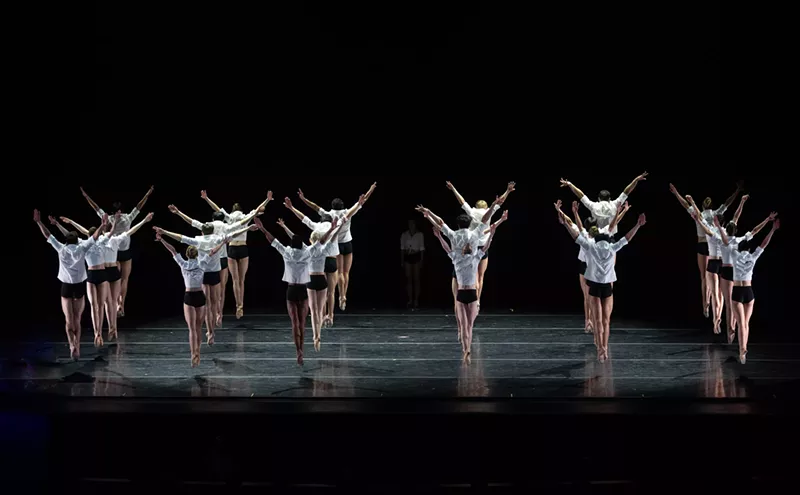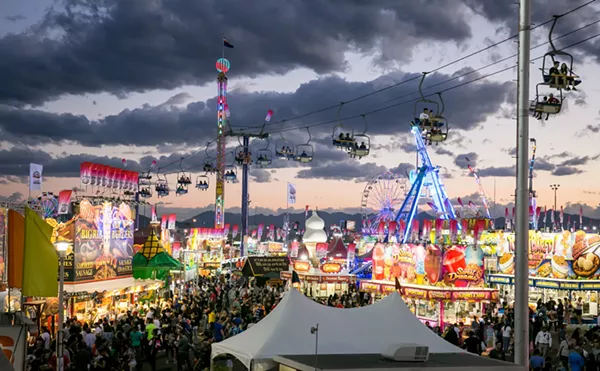Grand Canyon University's production of Georg Kaiser's 1918 play Gas I has scored a bull's eye on a virtual blind spot in my experience.
Never having seen productions of Capek's R.U.R., Cocteau's The Infernal Machine, or any of the 73 plays Kaiser apparently wrote in addition to Gas I, my knowledge of the expressionistic genre is minimal. Notes thoughtfully provided in the program, which were excerpted from The History of World Theater, explain that the ephemeral movement of expressionism can be dated from 1910 and lasted about ten years.
"The defining characteristics," the notes read, "include episodically constructed plots, abstract characters and distortions of reality calling for elaborate scenic effects to express the inner man or woman on a journey of discovery."
True to form, Gas I is set in an enormous industrial plant, with metal stairs, ramps and ladders, control panels, multilevel steel passageways connected by a hydraulic elevator, all confined beneath thick glass brick windows that glow faintly high above. At the rear of the factory, two gigantic flywheels rotate with an ominous, vibrating hum.
Paul B. Bridgeman's mechanistic set becomes the dominant character in a mechanical universe. The robotic human element is dwarfed by the scale and prominence of the gray environment. The sterile metal works are starkly lighted by director Claude N. Pensis, and Elizabeth A. Yoder's uniforms diminish all suggestion of individuality.
Kaiser's prescient play depicts a monolithic society with the kind of collective ideology that ultimately pervaded Eastern Europe for 70 years, and the bleak world of this gas-producing facility eerily recalls the spiritless faade of East Berlin before the fall of the Wall.
The play pits a utopian idealist (the Billionaire's Son) against the blind determination of an Engineer. Confident of the future, the Billionaire's Son has utopian plans for building "human habitation units" among landscaped parks. Dreaming of a better life than that afforded by the factory, he questions the chief Engineer about safety: "Supposing the gas should explode?" The query is greeted with incredulity.
The factory engines rumble along with mindless productivity, until lights and alarms begin to flash, the giant churning engines misfire and in a deafening roar, the gas explodes: Chernobyl foretold. The silence as the wheels limp to a complete stop is terrifying.
The Billionaire's Son's worst fears are realized. He is convinced that production must never start up again. But the government needs the gas for an unidentified war, so the Engineer insists the plant can safely reopen.
The factory workers (who share in the profits of the plant) rally behind the Engineer: When the plant restarts, the same formula will be used, but the Engineer is confident the accident could never repeat. It is impractical to change the gas, the Engineer reasons, because all the machines in the world would have to be rebuilt. The Billionaire's Son fights this plan vigorously, but the workers remain on strike until he capitulates.
The play in the translation by Winifred Katzin is formal in diction, with no contractions or idioms. At times, the stiff language reminds us of the cyberspeak of Saturday Night Live's Coneheads. There are, however, no attempts at humor. This is serious stuff.
Pensis has directed the cast to deliver the dialogue in dehumanized monotones, often with atonal choral effects that chill the blood. The entire company of 28 is effective in the portrayal.
Only the Billionaire's Son is allowed human dimension, and in a bold piece of intersexual casting, he is played with striking depth and subtlety by Christine J. Dunn. Her complex characterization of this central role is a welcome emotional oasis in a desert of strident humanoids.
The play is a tribute to the role of the writer as prophet, warning of the dangers of a dehumanized world on the brink of global conflict. But seen in the context of today's concerns, Gas I is no more than a curiosity. Our world has survived the threats Georg Kaiser imagines.
In spite of ample artistic resources, Grand Canyon University seems determined to present no play before it is safely irrelevant. Once again, it demonstrates significant dramatic skill in resuscitating an obscure seminal experiment that is both tedious and brief. This play runs about an hour, and one could hardly bear another minute.












